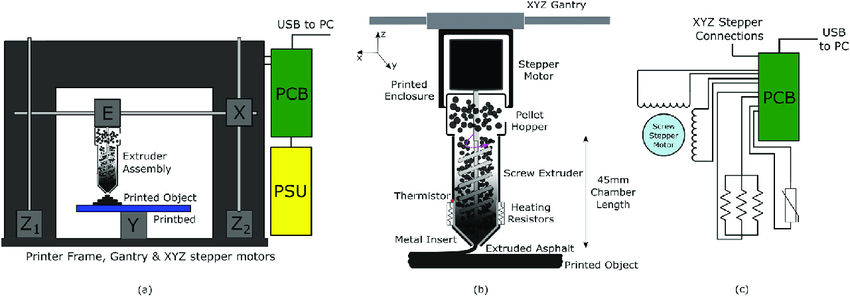 Asphalt is the most common material used to surface roads, for several reasons: it creates a safe, quiet surface for driving, it can be laid down quickly and without complex machinery, and it is tough and can be easily repaired. Asphalt composites do tend to degrade over time, however, leading to dreaded potholes. Potholes often start as cracks, which quickly expand. Road teams cannot be dispatched to repair every single crack that forms, so frequently damage to roads is significant before it gets repaired. One solution is to create autonomous drones or other vehicles that are equipped with robots capable of 3D printing asphalt. These drones can be sent to repair cracks in their early stages.
Asphalt is the most common material used to surface roads, for several reasons: it creates a safe, quiet surface for driving, it can be laid down quickly and without complex machinery, and it is tough and can be easily repaired. Asphalt composites do tend to degrade over time, however, leading to dreaded potholes. Potholes often start as cracks, which quickly expand. Road teams cannot be dispatched to repair every single crack that forms, so frequently damage to roads is significant before it gets repaired. One solution is to create autonomous drones or other vehicles that are equipped with robots capable of 3D printing asphalt. These drones can be sent to repair cracks in their early stages.
In a paper entitled “3D Printing of Asphalt and its effect on Mechanical Properties,” a group of researchers develop an asphalt 3D printer.
“The main difficulty encountered is that asphalt behaves as a non-Newtonian liquid when moving through the extruder,” the researchers state. Thus, the rheology and pressure in relation to set temperature and other operational parameters showed highly non-linear behaviour and made control of the extrusion process difficult. This difficulty was overcome through an innovative extruder design enabling 3D printing of asphalt at a variety of temperatures and process conditions.”
The researchers constructed the 3D printer using a frame and control system from a RepRap Mendel 90 3D printer. They 3D printed the extrusion nozzle assembly using a Form 2 3D printer. The stepper motor housing, PCB and serial port clip were also 3D printed, using another, unmodified Mendel 90. Asphalt pellets were created using a hard grade of bitumen, cast in a machined mold at a low temperature. Several test objects were 3D printed at a temperature range of 100° to 140°C. The researchers printed multiple different shapes, including standard test bars, which were subjected to tests that compared their strength to cast asphalt samples.
The mechanical properties of the 3D printed and cast asphalt samples were significantly different. The cast samples showed anisotropy between those tested with their top and bottom surfaces under compression.
“This anisotropy is likely due to the differences in their surface roughnesses, porosity, and volatile content between the top and bottom of the sample,” the researchers explain. “There were no differences seen in testing the 3D printed samples from top or bottom.”
The 3D printed specimens showed up to nine times the ductility of the cast samples, but their fracture strengths were similar. The increased ductility, according to the researchers, is “due to microstructural changes in the asphalt which result in crack-bridging fibres that increase toughness.”
According to the researchers, a 3D printer attached to a drone could be used not only to repair roads, but to repair hard-to-reach areas such as rooftops. Using autonomous machines could enable minor damage to be fixed before it turns into major damage, saving municipalities time and money and avoiding damage to vehicles.
“The next stage of developing this technology involves understanding the effect of environmental variables such as road temperature, air temperature, the local chemistry, interface with aggregate, as well as more comprehensive testing such as cyclic loading of repaired crack roads,” the researchers conclude.
Authors of the paper include Richard James Jackson, Adam Wojcik and Mark Miodownik.
Discuss this story and other 3D printing topics at 3DPrintBoard.com or share your thoughts in the comments below.
.
Subscribe to Our Email Newsletter
Stay up-to-date on all the latest news from the 3D printing industry and receive information and offers from third party vendors.
You May Also Like
Why Corrosive Resistant Materials Are Important to the Success of 3D Printing Across Industries
The adoption of additive manufacturing (AM) is accelerating across many major industries. As this technological shift unfolds, the importance of corrosion resistance has emerged as a challenge for 3D printing...
America Makes Announces IMPACT 2.0: $6.6M in New 3D Printing Funding
America Makes, the Manufacturing Innovation Institute (MII) based in Youngstown, Ohio, has announced IMPACT (Improvement in Manufacturing Productivity via Additive Capabilities and Techno-Economic Analysis) 2.0, a project call which will...
3D Printing Webinar and Event Roundup: April 14, 2024
We’re starting off the week’s 3D printing webinars and events at ASTM AMCOE’s 11th Snapshot Workshop and MACH Exhibition. Stratasys continues its advanced training courses, SME is holding a virtual...
AMUK Welcomes Airframe Designs as British 3D Printing Industry Grows
While the UK is not the hub for 3D printer and materials manufacturers as other nations, the country continues to excel at the research, development, and application of additive manufacturing...

































